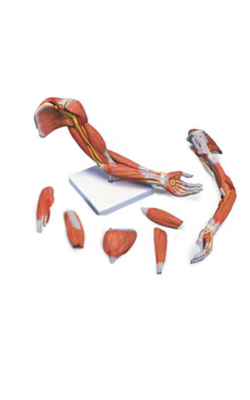Main Model

4 Radial artery

Radial Artery in Forearm
The pulsations of the radial artery can be felt throughout the forearm, making it useful as an anterolateral demarcation of the flexor and extensor compartments of the forearm. When the brachioradialis is pulled laterally, the entire length of the artery is visible. The radial artery lies on muscle until it reaches the distal part of the forearm. Here it lies on the anterior surface of the radius and is covered by only skin and fascia, making this an ideal location for checking the radial pulse.
The course of the radial artery in the forearm is represented by a line joining the midpoint of the cubital fossa to a point just medial to the radial styloid process. The radial artery leaves the forearm by winding around the lateral aspect of the wrist and crosses the floor of the anatomical snuff box.
• The radial recurrent artery participates in the peri-articular arterial anastomoses around the elbow by anastomosing with the radial collateral artery, a branch of the profunda brachii artery.
• The palmar and dorsal carpal branches of the radial artery participate in the peri-articular arterial anastomosis around the wrist by anastomosing with the corresponding branches of the ulnar artery and terminal branches of the anterior and posterior interosseous arteries, forming the palmar and dorsal carpal arches.
• The unnamed muscular branches of the radial artery supply muscles in the adjacent (anterolateral) aspects of both the flexor and the extensor compartments because the radial artery runs along (and demarcates) the anterolateral boundary between the compartments.
Radial Artery in Hand
The radial artery curves dorsally around the scaphoid and trapezium and crosses the floor of the anatomical snuff box. It enters the palm by passing between the heads of the 1st dorsal interosseous muscle and then turns medially, passing between the heads of the adductor pollicis. The radial artery ends by anastomosing with the deep branch of the ulnar artery to form the deep palmar arch, which is formed mainly by the radial artery. This arch lies across the metacarpals just distal to their bases. The deep palmar arch gives rise to three palmar metacarpal arteries and the princeps pollicis artery. The radialis indicis artery passes along the lateral side of the index finger. It usually arises from the radial artery, but it may originate from the princeps pollicis.
Radial Artery
Origin: As smaller terminal branch of brachial artery in cubital fossa
Course in Forearm: Runs inferolaterally under cover of brachioradialis; lies lateral to flexor carpi radialis tendon in distal forearm; winds around lateral aspect of radius and crosses floor of anatomical snuff box to pierce first dorsal interosseous muscle